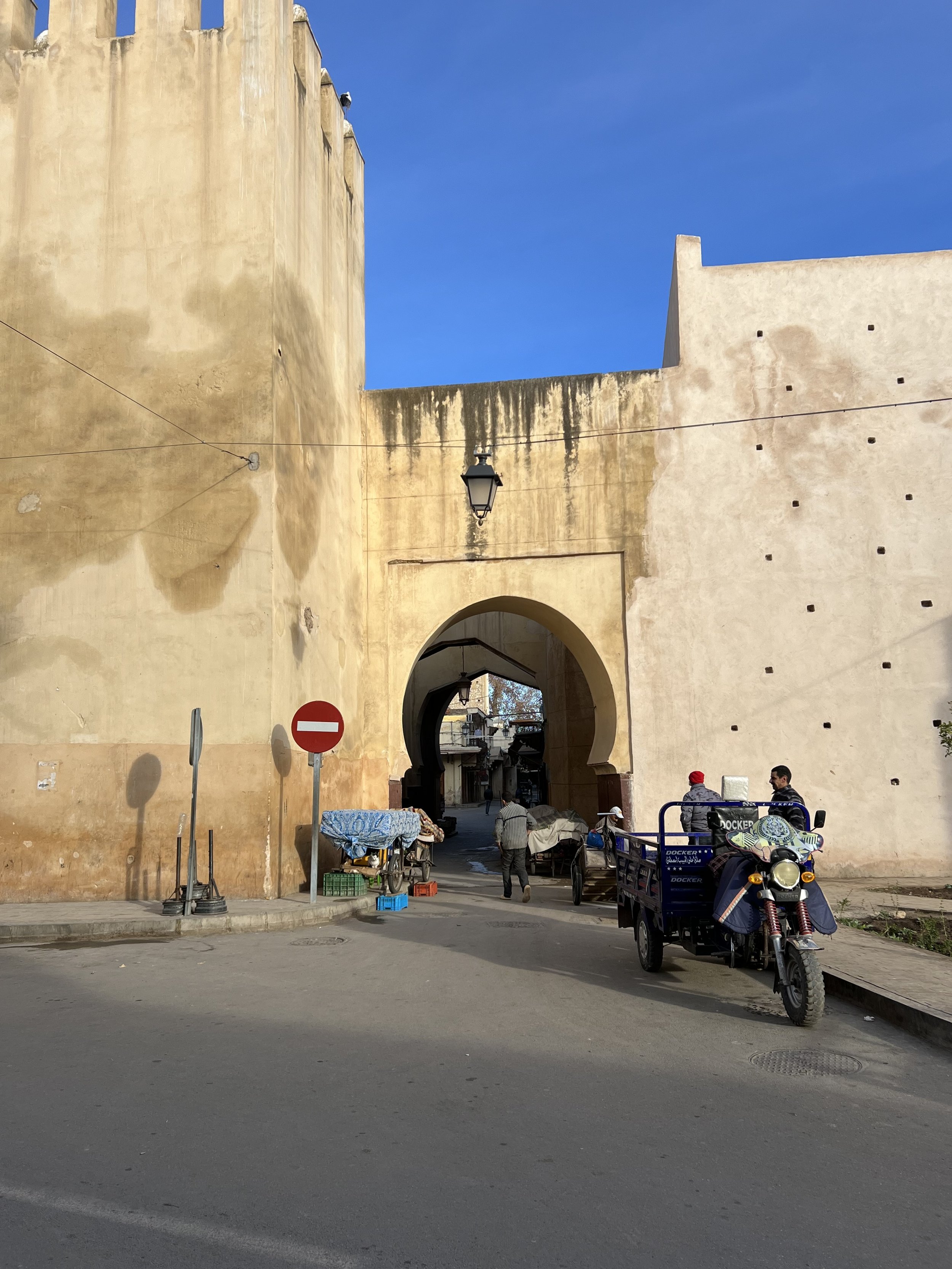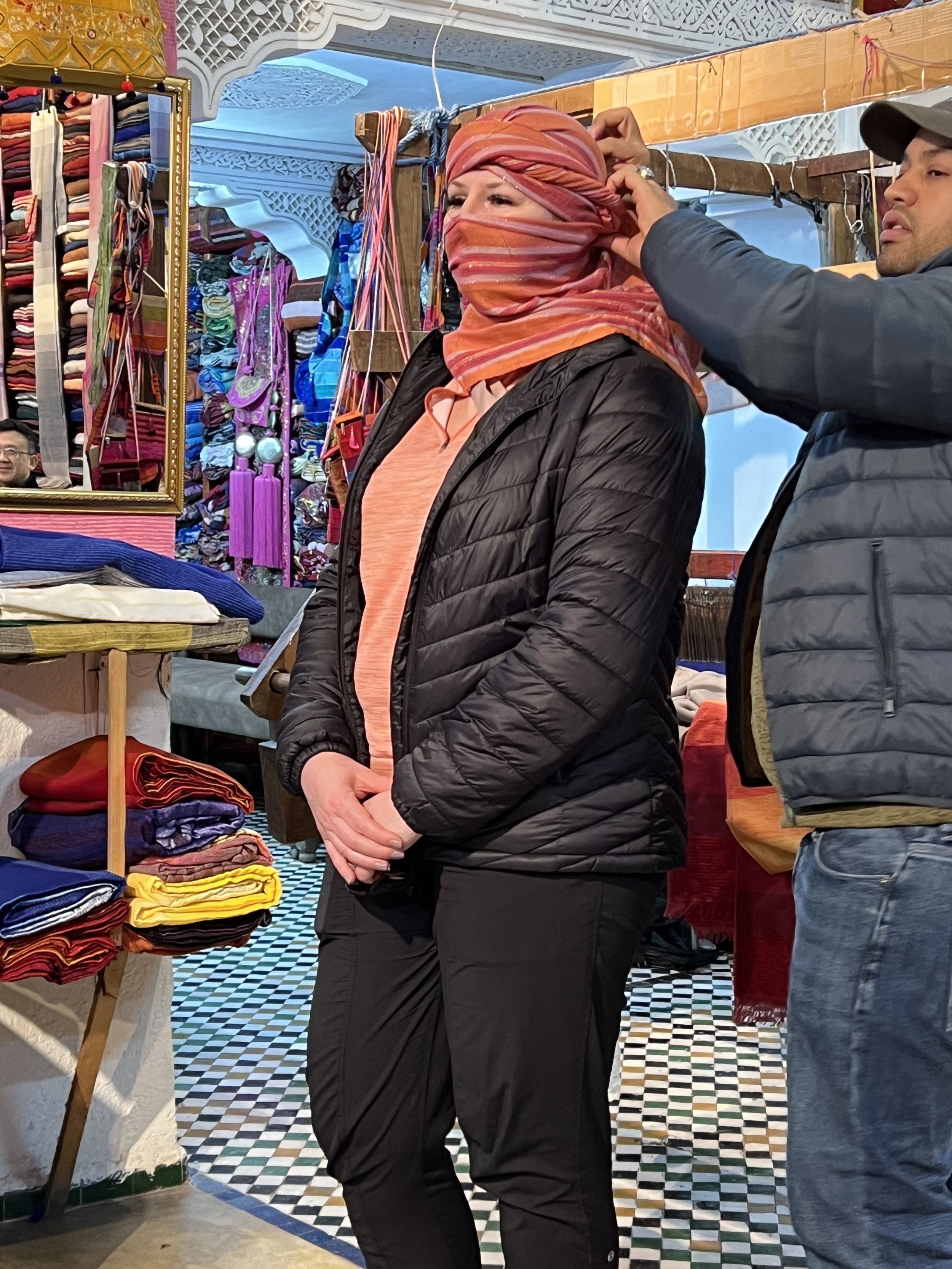Médina de Fés
“A person susceptible to wanderlust is not so much addicted to movement as committed to transformation.”
–Pico Iyer
Day 5—Sunday, January 14, 2024
We began our remarkable day in Fes outside the walls of the world-famous medina. (I most often saw the city name spelled as Fes, rather than Fez, so I’ve stuck with that spelling.) The bus dropped us off so we could walk past the Jewish Cemetery, stand outside the grand doors of The Royal Palace, walk down the charming Rue Bou Ksissat, and admire Bab Semmarine (“Gate of the Farriers”). We reboarded the bus and arrived at the hilltop Borj Sud (South Fort) for a commanding view over the ancient walled city of Fes, which contiained the massive labyrinth collectively known at the Médina de Fès.
Inside was an unimaginable collection of narrow, winding alleyways that revealed lowly street merchants around one bend and high-end vendors around another. There were countless mosques, madrasas (colleges for Islamic instruction), and old funduqs (merchant inns). Craftsmen of every kind. Food of every flavor. Merchandise for every need. Tight spaces meant only hand carts or donkeys were used to transport goods. It was a wild experience to say the least, and our day-long visit was one of the highlights of the trip—a truly unforgettable experience you had to experience to believe.
Sunrise over Fes as seen from the Hôtel L’Escale restaurant.
The main gates to The Royal Palace in Fes.
Close-up of the elaborate detail on the gates at The Royal Palace.
The northern part of Rue Bou Ksissat, with its luxurious and richly decorated homes largely owned by Jewish immigrants from Spain.
More storks
Bab Semmarine (“Gate of the Farriers”) is the monumental and highly fortified southern gate into the old city, featuring a double set of walls.
Jews used the smaller gate to the right of Bab Semmarine.
The American Fondouk was founded in 1927 at the behest of Amy Bend Bishop, an American traveler who was distressed by the poor conditions of the many working animals in Fes Medina. At the time, there were 40,000 pack animals living in and around Fes. As in any country dependent on subsistence agriculture, Morocco’s draft and pack animals were worked hard by owners who were often poor and uneducated. The animals needed good veterinary care, improved husbandry and nutrition, and humane handling—both for their own sake and for the sake of the families who depended on their labor. Upon her return to the U.S., Mrs. Bishop contributed $8,000 in memory of her mother as seed money to build a refuge for these animals. With this donation, some hard work, and the help of a few dedicated friends, the American Fondouk was established. With limited resources and an endless need, contributions of any size make a tremendous difference in the Fondouk’s ability to treat the maximum number of animals in need of care. The American Fondouk continues to be a charitable veterinary hospital, providing free treatment for thousands of animals each year.
From the vantage point of Borj Sud (South Fort), the massive Fes Medina resides amongst the sprawling sea of buildings that engulf the valley below.
At South Fort
We’re goin’ in!
The 1200-year old walled Fes Medina contains 9,454 cobbled alleyways and some 300 mosques.
Yum
I ate more olives during these ten days than I’d probably eaten in my previous lifetime; the black olives were particularly flavorful!
Such wonderful presentation of the various offerings.
Dave, Natasha, and me.
Cloth dying vat
Dyed cloth hanging everywhere.
Metal engraving is an ancient craft, and it means engraving on copper, silver, and gold. The craft began in Morocco in the late twelfth century and early thirteenth century in the city of Fes. Over the years it spread to other cities in Morocco, especially Marrakesh.
Finished product: in this case a wedding platter with 7 intertwined rings representing the days of the week, surrounded by a necklace on the inner platter, and a belt around the outer platter.
Completely designed by hand. Today the trade is supported by UNESCO in order to protect this vital part of Morocco’s “intangible heritage.”
The metal work and engraving shop.
We visited a rug dealer.
They plied us with mint tea to soften us up.
“We can ship rugs anywhere in the world!”
I wasn’t tempted to buy a rug, but I almost brought back for Amanda some cedar kitchen utensils.
Peering inside a mosque deep inside the medina.
Intricate carvings.
Another of the mosque’s entrances.
Built in the 18th century, Funduq Barka is one of four recently rehabilitated funduqs in the medina of Fes. Funduqs provided services and accommodations for merchants and travelers from outside the city. Animals were stabled on the ground level, goods intended for sale could be stored, and guests stayed in the upper levels.
Funduq Staouniyyin was founded in the 14th century. The name Staouniyyin or Tetwaniyyin means "people from Tetouan" (a city in northern Morocco), suggesting that merchants in Fes were historically grouped together by origin.
Seffarine gets its name from the coppersmiths who practice one of the most important handcraft jobs in the history of Fes.
Possessing ancestral knowledge, coppersmiths and boilermakers still work in the square, pounding copper and brass in a remarkable orchestra of sound.
Out of their expert hands come a wide variety of utensils and tools, such as pots, pans, buckets, incense burners, trays, teapots, tea and sugar boxes, footed strainers, kettles, couscous steamers, samovars, and more.
The only mode of moving large or heavy goods through the medina.
Qaraouiyine Mosque, the most emblematic landmark of the city of Fes and a true icon of Moroccan architecture.
While we couldn’t enter the mosque, we were able to visit Al Attarine Madrasa—a 14th-century school for Islamic studies featuring ornate tile work & dramatic architecture
In a cloth shop, Cayla demonstrated proper headwear for full sun protection (SPF 1,000).
Andy rocking it in shades of grey.
Dave sporting a more professorial look.
Lunch deep inside the Medina at Le Patio Bleu consisted of a mixed salad shared by the table (above). (A “salad” in Morocco is in the truest sense of the definition: a dish consisting of mixed ingredients, frequently vegetables. Here you see carrots, olives, beans, beets, squash, and bread.) Everything was delicious!
My main dish was vegetable couscous with potatos, carrots, squash, chickpeas, and raisins. Spoon on broth for added flavor; but, the real zest was in the spicy red sauce—just a dab with each bite gave the plate the perfect zing!
Wash it all down with a Flag Spéciale pilsner.
The last stop in the medina was a vegan’s delight: a massive leather vendor with views overlooking Chouara Tannery. Chouara Tannery is one of three tanneries in the city of Fes.
When in full swing (above), it’s even more richly colored than during our visit. (It probably also smelled a lot more of pigeon poop and urine, key ingredients in the vats.)
An array of leather house slippers for sale.
Our guide Abdul prearranged for this guy (I’m so sorry I don’t remember his name) to be the “sweep” for our group as we wondered the vast warren of the medina. He was a real character who, if you hung out at the back, would drag you off to cool side highlights and then run to catch back up with the group. He ensured no one got left behind, but also made our time in the medina especially memorable.
We eventually departed the medina, but made one final stop at Art D’Argile, a large shop specializing in Moroccan mosaics and ceramics. My boys would have loved to “throw down” on the pottery wheel.
Beautifully handcrafted work by true artisans. What a day! Now back for a second night in our hotel in Fes. We spend tomorrow night in the Sahara Desert.



























































